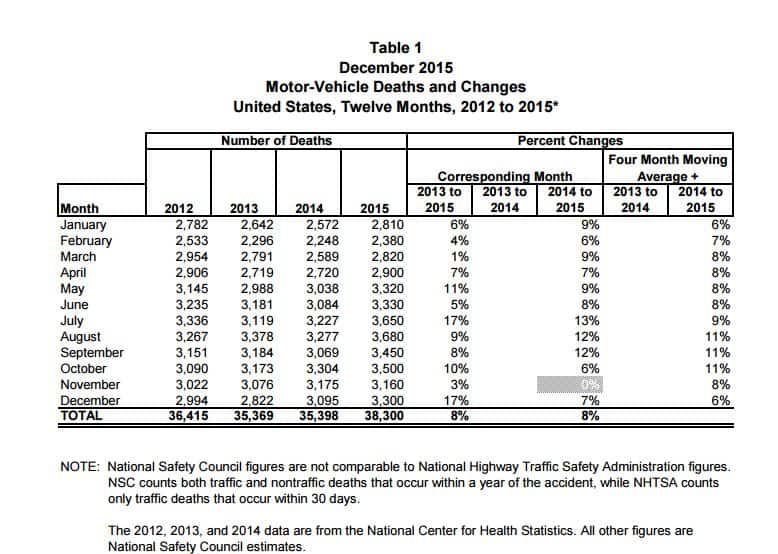 Preliminary estimates from the National Safety Council indicate motor vehicle deaths were 8 percent higher in 2015 than they were in 2014 – the largest year-over-year percent increase in 50 years. The National Safety Council estimates 38,300 people were killed on U.S. roads, and 4.4 million were seriously injured[i], meaning 2015 likely was the deadliest driving year since 2008.
Preliminary estimates from the National Safety Council indicate motor vehicle deaths were 8 percent higher in 2015 than they were in 2014 – the largest year-over-year percent increase in 50 years. The National Safety Council estimates 38,300 people were killed on U.S. roads, and 4.4 million were seriously injured[i], meaning 2015 likely was the deadliest driving year since 2008.
Over the last year at the state level, the National Safety Council estimates Oregon (27 percent), Georgia (22 percent), Florida (18 percent), and South Carolina (16 percent) all experienced increases in fatalities, while only 13 states showed improvement. Among them, New Mexico (-20 percent), Kansas (-7 percent) and New Jersey (-2 percent) experienced substantial decreases.
“These numbers are serving notice: Americans take their safety on the roadways for granted,” said Deborah A.P. Hersman, president and CEO of the National Safety Council. “Driving a car is one of the riskiest activities any of us undertake in spite of decades of vehicle design improvements and traffic safety advancements. Engage your defensive driving skills and stay alert so we can reverse this trend in 2016.”
The estimate is subject to slight increases or decreases as data mature. NSC has issued annual traffic fatality estimates since 1921. Over the last three years, preliminary estimates have fallen within 1 percent of final counts.
While many factors likely contributed to the fatality increase, a stronger economy and lower unemployment rates are likely at the core of the trend. Average gas prices were 28 percent lower in 2015 than in 2014 and are projected to continue dropping this year,[ii] making driving more affordable for many Americans. The U.S. Department of Transportation estimates a 3.5 percent increase in the number of miles driven in 2015 compared to 2014[iii].
To help ensure safety, the National Safety Council recommends drivers:
- Make sure every passenger buckles up on every trip
- Designate an alcohol and drug-free driver or arrange alternate transportation
- Get plenty of sleep and take regular breaks to avoid fatigue
- Never use a cell phone behind the wheel, even hands-free
- Stay engaged in teens’ driving habits, as teens are three times as likely to crash as more experienced drivers
- Learn about your vehicle’s safety systems and how to use them. My Car Does What can help drivers understand features such as adaptive cruise control, blind spot warning systems and backup cameras.
